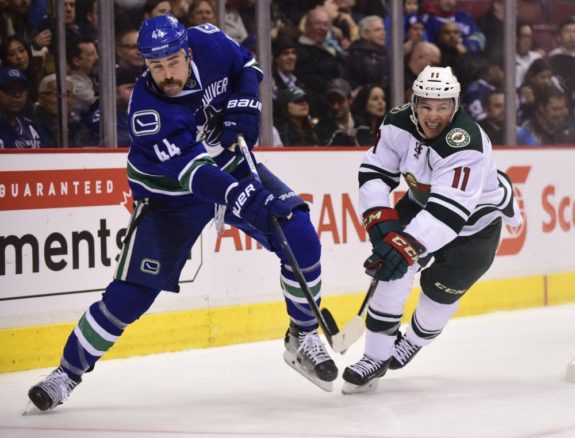![]()
Jim Rutherford has done it again. No, he didn’t hoist the Stanley Cup for the fourth time as a general manager, nor win another NHL Executive of the Year Award or even make the biggest splash at the NHL trade deadline as he did last season. He has traded for defenseman Erik Gudbranson and, in doing so, once again has drawn the collective ire of the analytics crowd.
Despite leading the Pittsburgh Penguins to back-to-back Stanley Cups in 2016 and 2017 and losing to the eventual Stanley Cup champion Washington Capitals last season, Rutherford, according to his critics, “has lost his damn mind” and, after a series of unforgivable acquisitions, someone in the Penguins organization “needs to take the keys away” and presumably show him the door.
Rutherford Adds Toughness
His original sin was the much-debated trade to acquire the heavy-hitting Ryan Reaves at the 2017 NHL Entry Draft, less than a month after the Penguins became the first team in the salary cap-era to win back-to-back Stanley Cups.
Then came his signing of rugged defenseman Jack Johnson that created so much backlash that he recently took the unusual step of publicly defending Johnson and accusing some fans of never giving him “a fair chance.”
Now comes the third strike with his trade of Tanner Pearson to the Vancouver Canucks in exchange for the 6-foot-5, 217-pound Gudbranson whose poor possession metrics, according to the Corsi crowd, make him a liability and make Rutherford look foolish for acquiring him.

With a career mark of minus-97, including a league-worst minus-28 rating this season prior to joining the Penguins, Gudbranson clearly has struggled at times over the past few seasons and even admitted that he was “not too proud” of his performance with the Canucks. However, critics who accuse Rutherford of dooming the Penguins’ Stanley Cup aspirations in one fell swoop are missing the big picture.
The reality is that adding Gudbranson in exchange for a struggling Pearson, at best, adds some needed muscle to a Penguins’ blue line that at times has looked ill-equipped for a long and grueling playoff series (assuming they make the postseason) and, at worst, is simply a case of “nothing ventured, nothing gained.”
Rutherford simply traded an underachieving 26-year old winger with two years remaining on his contract at $3.75 million per year for a 26-year old underachieving defenseman with two years remaining at $4 million. If there was a better option out there, Rutherford couldn’t find it and neither can his critics.
Injuries on the Blue Line Pile Up
With the emergence of Teddy Blueger, the recent acquisitions of Nick Bjugstad and Jared McCann and the return of Zach Aston-Reese from injury, the Penguins, on one hand, are so deep at the forward position that Pearson, a 20-goal scorer just two seasons ago with the Los Angeles Kings, had been the odd man out and relegated to the press box as a healthy scratch.
On the other hand, injuries to defensemen Ollie Maatta, Kris Letang and Brian Dumoulin had decimated the Penguins’ blue line so much so that they have had to turn to Zach Trottman, a 28-year old journeyman with just 71 games of NHL experience, to fill the void.
With the Penguins in the unusual position of fighting for a playoff spot and with no timetable for the return of any of their top defensemen, something had to be done.

Ideally, Rutherford could have acquired a diamond in the rough like Justin Schultz in exchange for just a third-round pick as he did at the 2016 Trade Deadline. After languishing with the Edmonton Oilers, Schultz has become a dynamic two-way defenseman and was a key member of the Penguins’ blue line for each of their back-to-back Stanley Cup runs.
Or, Rutherford could have dealt a second-round pick and a prospect to a rebuilding team for a steady veteran as he did when he acquired Ron Hainsey from the Carolina Hurricanes at the 2017 Trade Deadline in an effort fill the void left by the season-ending neck injury to Kris Letang. Hainsey averaged over 20 minutes of ice time per game in both the regular season and playoffs and helped the Penguins repeat as Stanley Cup champions.
The fact is that trade opportunities like these are few and far between and, even if a similar situation presented itself, Rutherford didn’t have a second or a third-round pick to spend this season as he had been forced to trade them away as part of his two-year search for a third-line center to replace the departed Nick Bonino.
While some may criticize Rutherford’s acquisition of Gudbranson as a desperate move, when a team is missing its top-three defensemen and barely holding on to a playoff spot with less than a month remaining in the season, as the Penguins are, being desperate is not a bad thing.